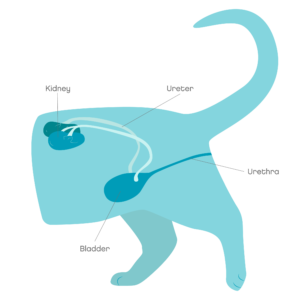Urine tests in dogs are used to check their wee for signs of infection and other issues. It’s performed frequently as it provides a lot of information. A urine sample can be easily collected without stressing your dog.
Also called urinalysis, it includes several tests, such as a dipstick, specific gravity, and laboratory tests. Urine can also be checked under the microscope to get even more information. it is a valuable test for both healthy and sick animals and should be included in any comprehensive evaluation of a dog’s health.

What it’s for
Why do dogs need urine tests?
A urine test can be used to:
- Screen the urinary system
- Vets can use this to identify urinary infections (UTI), bladder stones, blocked bladder problems and even cancer.
- Check the kidney function
- This is important when dealing with kidney problems (such as chronic kidney disease).
- Look for signs of other organ disease
- This test can be used to detect sugar in the urine of a diabetic dog. Other hormonal diseases can be detected by a change in urine concentration, such as Cushing’s disease.

- Anatomy of the urinary tract system
When do dogs need a urine test?
Your vet may recommend a urine test as part of screening lab work to assess your dogʼs health, or if they are showing any of the following signs:
- Weeing and/or drinking more than normal
- Straining to urinate
- Blood in the urine
- Weeing in inappropriate places
- Weight loss
- Vomiting
What do urine tests measure?
Urine tests can measure different things depending on the type of test as well as the type of urine collection method.
The most common types of urine tests are:
Dipstick
Paper dye chemical test that indicates the presence of blood, glucose, protein and other important parameters present in the urine. Quick and cheap to do.
Urine Specific Gravity (USG)
Test to assess the concentration of the urine.
Urine sediment
Microscopic evaluation that can detect bacteria, crystals, cells and other solid material in the urine.
Urine culture and sensitivity
More accurate to detect an infection in the urine and determine the correct antibiotic to be used. The urine sample has to be sent to an external lab.
Protein to creatinine ratio
This test provides a more accurate measure of the amount of protein in the urine. This is important information when assessing the kidney function.
How it’s done
How to collect a urine sample in dogs
Urine collection methods can influence the accuracy of detecting a bacterial infection.
Free catch
During normal urination, a sterile container is used to collect the urine sample.
- Advantages: non-invasive method, and you can collect the sample at home.
- Disadvantages: not all owners can achieve this, and it can be especially difficult in bitches. The sample may also be contaminated, making it less accurate in detecting urine infections.
Cystocentesis
A sterile needle and syringe are used to collect urine directly from the bladder.
- Advantages: the urine is not contaminated, making it very useful for detecting bacterial infections.
- Disadvantages: invasive method, although it doesn’t cause much discomfort can only be done in cooperative patients, unless they are sedated. Unlike other methods, it is useful only if the bladder is full.
Catheterization
A sterile thin rubber tube is passed up from the genital passage into the bladder.
- Advantages: this method allows multiple sterile urine sample collections in hospitalised patients.
- Disadvantages: placing the tube requires anaesthesia, can cause irritation through its passage, and the tube can carry bacteria up to the bladder especially if left in for too many days.
Collecting a urine sample at home
- Your vet can provide a sterile urine sample container, specially designed for urine collection in dogs.
- You can also use a clean, wide-necked container, such as a small bowl or dish.
- Some dogs and bitches will stop weeing every time you approach them with your container. That forces us to get creative!
- Use a stick or a long object to attach the container to help you collect the urine by still keeping some distance.
- Place an unused plastic bin liner near the area where your dog pees, and if they do, you can collect the urine with a spoon or a syringe.
- If you can’t collect a urine sample and your dog urinates on a clean floor, you can use a syringe or a pipette to collect it. When taking it to your vets make sure to inform them where it was collected from so they can decide if they can use it.
Costs
How much does it cost to do a urine test?
Cost depends:
- On the type of test and if any procedures to collect the urine sample are required.
- If the urine test is run at the vet practice or sent to a special laboratory.
- If your dog suffers from a long-term condition, they may need regular blood and urine tests for monitoring purposes and treatment adjustments.
Risks
Some urine collection methods may involve risks
- Cystocentesis
In rare cases, it can lead to bladder rupture, urine leakage inside the tummy or accidental puncture of other organs.
To avoid these risks, your vet uses an ultrasound scanner as a guide, and in some cases, sedation may also be used to allow the dog to remain calm and still.
- Catheterization
Any procedure that involves anaesthesia has risks associated with it.
If the tube that is placed, called catheter, is left in for too long it can lead to urinary tract infections.
Are there any human health concerns to consider?
- When collecting your dog’s urine at home you should wear gloves or wash your hands thoroughly afterwards.
- If you can’t take the fresh sample to your vet within 30 minutes we recommend you store it in the fridge and take it to them as soon as possible. Put the sample in a second container to avoid any contact with the contents of your fridge.
Recovery tips
What to expect from your dog when recovering from a cystocentesis
Cystocentesis is a very small and safe procedure that usually does not need any recovery time unless sedation is required.
When to worry
Things to watch out for if your dog had a cystocentesis
Rarely, a cystocentesis can cause urine leakage and inflammation inside the tummy, called peritonitis. <link to peritonitis>
The main symptoms of peritonitis are:
- Weakness and lack of energy
- Reduced appetite
- Vomiting
- Diarrhea
- Painful tummy
Contact your vet if you see any of these signs.
Joii can help with:
- Identifying signs that need a physical vet visit.
- Advising on how to collect a urine sample at home and how to store it.
- Advising on how to help your dog cope with repeated vet visits.








